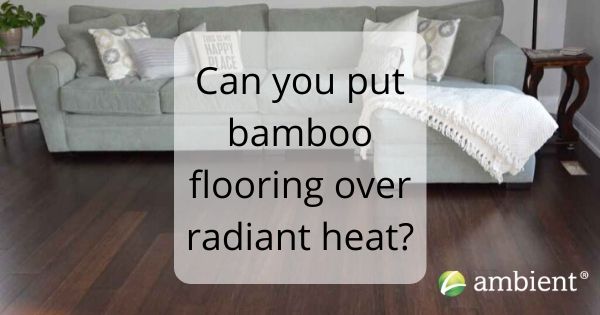Short answer: Yes — but with care. Bamboo flooring, especially engineered bamboo, can perform beautifully over radiant heating systems if installed properly. But not all radiant systems are created equal, and there are some key guidelines you’ll want to follow to ensure your floors last and stay gorgeous.
Let’s dive into how radiant heat works, which bamboo products are best, and the do’s and don’ts of installation.
Radiant floor heating systems are a popular construction feature in new home construction. They are also great for large-scale home renovation projects. They can be expensive to install, but several benefits make them appealing to homeowners. By utilizing convection mechanisms, radiant heating provides an energy-efficient heat source for your home. It’s effortless to run – a safe heat source that provides added comfort – and relatively easy to install.
What Is Radiant Floor Heating?
Radiant heating warms your home from the ground up by sending heat through the floor itself — either via warm water tubes (hydronic), electric coils, or hot air.
Why it’s awesome:
Quiet, even heat
No dust or allergens blowing around
Energy-efficient
Space-saving — no radiators or vents
What Does Radiant Heating Cost?
Expect to pay: (2025 prices below!)
$5–$7 per sq ft (materials only)
$8–$12 per sq ft (with professional install)
The long-term savings on heating bills and the added comfort can make it worth every penny.
According to Energy.gov, radiant heating is more efficient than baseboard heating. Additionally, it’s usually more efficient than forced-air heating because it eliminates duct losses. An additional benefit is one for anyone suffering from allergies. Radiant heating doesn’t distribute allergens as forced-air systems do. Energy.gov also says that a hydronic system (liquid-based radiant heating) uses minimal electricity. This is good for homes that are either off the power grid or in areas with high-priced electricity.
Types of radiant floor heating systems
1. Hydronic Radiant Heating (Best for Bamboo)
Uses hot water circulating through tubes under the floor
Gentle, consistent heat
Great temperature control
✅ Best compatibility with wood and bamboo floors
2. Electric Radiant Heating
Uses heating wires or mats under the floor
Heats up fast, but can create hot spots
⚠️ Not all bamboo floors are compatible — more on this below
3. Radiant Air Heating
Uses heated air in tubes beneath the floor
Least common (and least efficient) option
Can Bamboo Flooring Handle Radiant Heat?
Absolutely — as long as you choose the right type and follow best practices.
✅ Best choice:
Engineered bamboo flooring — it’s more dimensionally stable and handles heat fluctuations better than solid wood or solid bamboo.
⚠️ Be cautious with:
Solid bamboo over radiant heat — it requires careful installation and temperature control.
Hydronic vs Electric Radiant Heat — What’s the Difference for Flooring
| Feature | Hydronic (Water) | Electric (Wires/Mats) |
|---|---|---|
| Heat delivery | Slow, even, consistent | Fast, can create hot spots |
| Temperature range | Mild and steady | Can spike and overheat |
| Floor compatibility | Bamboo-friendly 🌱 | Riskier for wood-based floors ⚠️ |
| Best for bamboo? | ✅ YES | ❌ Only with extreme caution |
1. Read the NWFA Radiant Heat Guidelines
The National Wood Flooring Association (NWFA) offers official installation protocols. Your installer should be familiar with them. You can check them out here.
2. Acclimate Your Flooring
Let the bamboo planks sit in the room for at least 3–7 days with radiant heat running at 75–80°F. This helps the planks adjust to the environment and prevents warping.
3. Install using either the Glue Down or Floating Floor Methods
Nail-down methods can damage radiant tubing. Instead, use a glue-down method (with vapor protection adhesive) or install an engineered floor via the floating system over a quality underlayment.
If you’re floating an engineered bamboo floor, ensure to use 3 in 1 underlayment that is at least 2mm thick. If you’re gluing the floor down (required for solid wood, optional for engineered), make sure to use an adhesive with vapor protection to insulate and protect your floor, and make sure your spread rate is at least 2mm thick.
4. Keep Temperatures Consistent
Never let subfloor temps exceed 85°F
Avoid sudden temperature swings (no more than 5°F per day)
Check out our full set of installation instructions: Bamboo Flooring Installation Guide
Final Tip: Ask the Pros!
Not all bamboo floors are created equal. At Ambient®, our strand-woven and engineered bamboo floors are tested for radiant heat compatibility — and we’re happy to walk you through the best options for your project.
👉 Call us at (866) 710-7070 or chat with a specialist anytime.

About the Author
Meet Jo Lynn! 🌿🧹 With more than a decade of eco-cleanliness expertise under her belt, Jo Lynn is on a mission to turn spaces into healthier, greener sanctuaries. Her journey into sustainable home maintenance started with a deep love for the environment and a determination to whip up non-toxic solutions that actually work.
Whether it’s a cozy home or a bustling office, Jo Lynn knows how to keep spaces spotless without compromising your health or our planet’s well-being. Plus, rumor has it, her cleaning jokes are so good, even the dust bunnies can’t help but chuckle! 😄

